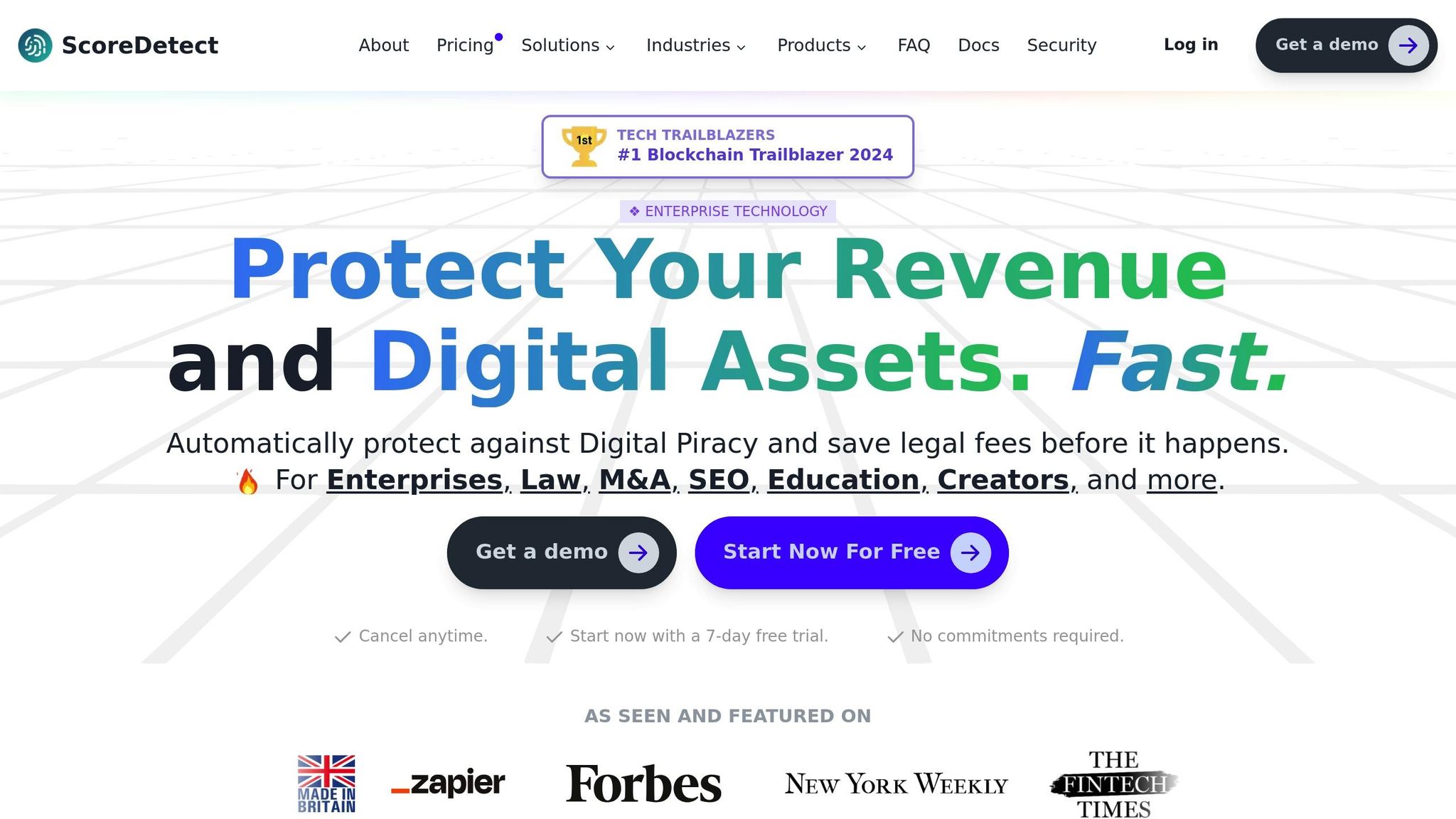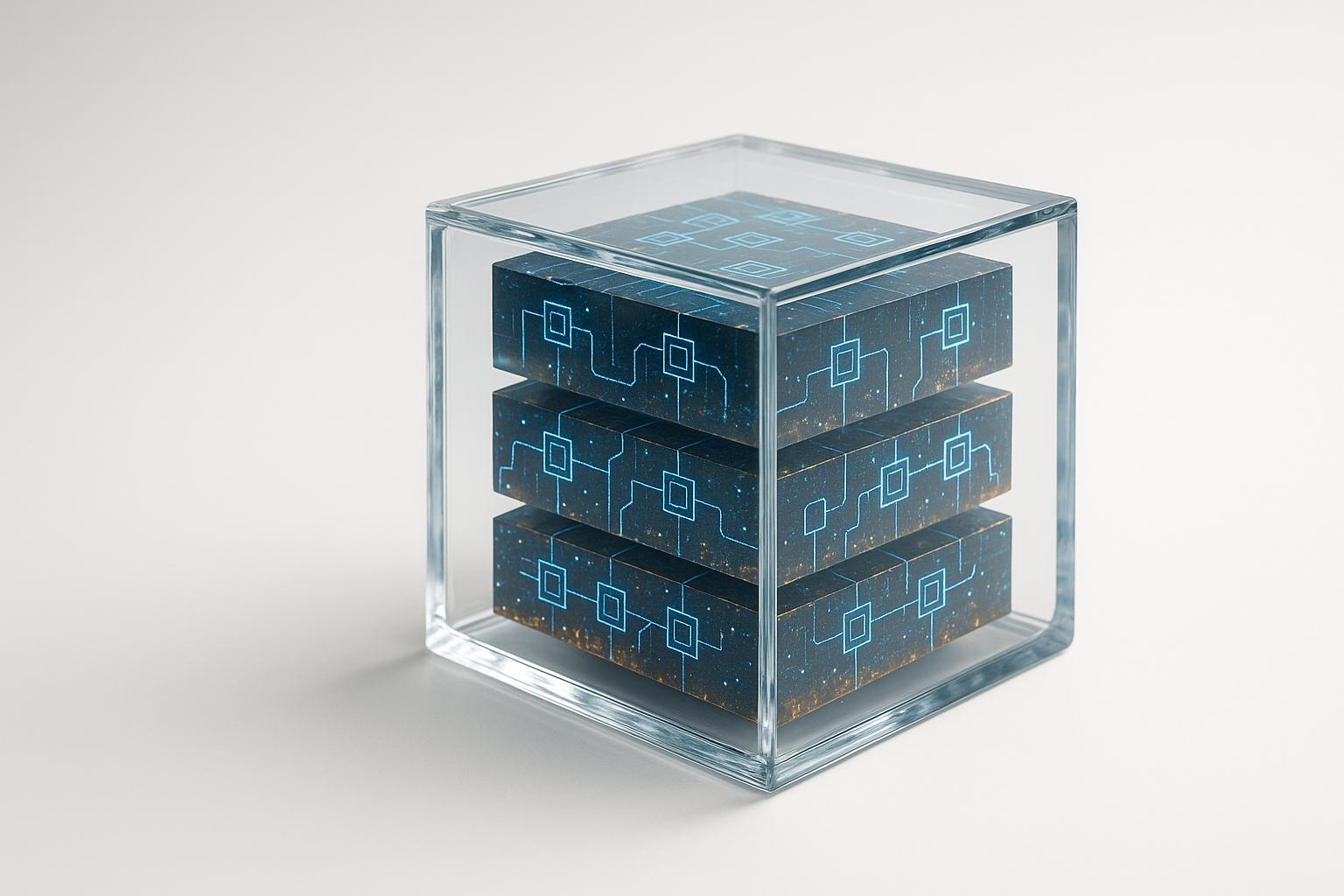Multi-Factor Authentication (MFA) is one of the most effective tools for combating digital piracy. By requiring multiple layers of verification – like passwords, devices, or biometrics – MFA blocks over 99.9% of account breaches, protecting sensitive content and digital assets. Here’s why it matters:
- Why MFA Works: Passwords alone are weak. MFA adds extra layers of security, stopping credential theft, brute-force attacks, and phishing attempts.
- Impact on Piracy: Streaming platforms, software companies, and publishers use MFA to limit illegal sharing of content, reducing piracy risks and revenue losses.
- Business Benefits: Beyond security, MFA helps meet U.S. regulations, improves customer trust, and safeguards intellectual property.
- Limitations: While MFA secures access, it doesn’t prevent legitimate users from misusing content. Pairing MFA with tools like ScoreDetect – which uses watermarks and AI monitoring – provides a stronger defense.
MFA is a must-have for U.S. businesses, especially in industries where content theft is rampant. Combine it with advanced anti-piracy tools for a complete security strategy.
How Multi-Factor Authentication Stops Digital Piracy
What Multi-Factor Authentication Is
Multi-Factor Authentication (MFA) adds an extra layer of protection to digital content by requiring users to provide two or more distinct credentials to gain access.
"MFA is a layered approach to securing data and applications where a system requires a user to present a combination of two or more credentials to verify a user’s identity for login." [3]
MFA leverages three types of verification factors:
- Something you know: This includes passwords, PINs, or answers to security questions.
- Something you have: Examples are physical devices like smartphones, hardware tokens, or smart cards that generate or receive authentication codes.
- Something you are: Relies on biometric traits, such as fingerprints or facial recognition.
This combination of factors makes it challenging for digital pirates to exploit vulnerabilities, as they would need to bypass multiple layers of security.
How MFA Blocks Common Piracy Methods
MFA is highly effective at neutralizing several common piracy tactics:
- Credential-stuffing attacks: Even if hackers manage to steal usernames and passwords, the additional verification step prevents unauthorized access.
- Brute-force attempts: Automated guessing of passwords becomes useless when a second factor is required.
- Phishing attacks: Even if users unknowingly share their passwords through deceptive websites or emails, the lack of a second factor stops intruders in their tracks.
With over 80% of cyber breaches linked to stolen or weak passwords [2], MFA provides a critical safeguard. In fact, accounts protected by MFA are 99% less likely to be compromised [3].
Each authentication factor has its own strengths and weaknesses:
| Authentication Factor | Advantages | Disadvantages |
|---|---|---|
| Something You Know | Easy to use and reset if compromised. | Vulnerable to guessing, phishing, or weak password choices. |
| Something You Have | Offers added protection even if passwords are breached. | Devices can be lost, stolen, or damaged, and there are costs associated with issuing tokens. |
| Something You Are | Biometric traits are difficult to replicate and eliminate the need for passwords. | Requires careful handling of biometric data, risks false readings, and biometric information cannot be replaced if compromised. |
MFA Use Cases for Digital Content Protection
MFA has become a go-to solution across industries to combat piracy and secure digital assets:
- Streaming Media: Streaming platforms, which account for 63% of pirated content distribution [1], use MFA to protect user accounts and limit unauthorized sharing of premium content.
- Academic and Research Publishing: MFA safeguards access to digital libraries and subscription-based research, reducing the risk of educational content piracy.
- Software Development: MFA ensures that only authorized personnel can access source code and proprietary tools, protecting intellectual property.
- Enterprise Content Management: Businesses rely on MFA to secure sensitive documents and intellectual property, mitigating risks from both external breaches and internal misuse.
With piracy website visits expected to surpass 215 billion in 2024 – a staggering 18% increase from the previous year [1] – organizations that implement MFA report significantly fewer cases of unauthorized access and content distribution. This makes MFA a powerful tool in the fight against digital piracy.
Business Benefits of Multi-Factor Authentication
Better Content Security and Piracy Prevention
Multi-Factor Authentication (MFA) doesn’t just block unauthorized access – it plays a key role in bolstering overall security and trust for businesses. By significantly reducing instances of unauthorized access and content theft, MFA protects both revenue and digital assets. In fact, over 99.9% of compromised accounts lack MFA protection [4], making it one of the most effective tools available for safeguarding sensitive information.
For industries like streaming services, software companies, and digital publishers – where subscription models are the backbone – MFA disrupts the methods digital pirates use to distribute stolen content. This added security layer is critical for maintaining the integrity of their offerings.
The rising demand for stronger security solutions is reflected in the market’s growth, which is projected to expand from $10.3 billion in 2020 to $40 billion by 2030 [4]. This trend highlights how businesses increasingly rely on MFA to protect their digital assets and revenue streams. Beyond security, these improvements also support regulatory compliance and foster greater customer confidence.
Meeting U.S. Regulatory Requirements
MFA goes beyond piracy prevention; it is also essential for meeting strict U.S. regulatory standards. Federal mandates such as FISMA, HIPAA, and GLBA require MFA to safeguard sensitive data, helping organizations avoid hefty financial penalties [5][6]. For instance, the Federal Trade Commission can impose fines of up to $46,000 per day for each breach [6]. Additionally, the Cybersecurity Information Sharing Act (CISA) encourages businesses to adopt advanced security measures like MFA as part of a broader threat protection strategy [5].
In this regulatory landscape, MFA has become a critical tool for maintaining compliance and avoiding costly sanctions. It’s not just about meeting legal requirements – it’s about building a resilient security framework that aligns with evolving threats.
Improving User Trust and Business Reputation
Adopting MFA sends a strong signal to customers about a company’s dedication to security. By protecting credentials and reducing risks, MFA not only ensures compliance but also fosters customer trust. This trust translates into loyalty and enhances a company’s reputation.
The business value of MFA is clear, with market projections anticipating growth to $17.76 billion by 2025 [4]. In a competitive environment, strong security measures like MFA act as differentiators that influence purchasing decisions. Customers are more likely to stick with businesses that prioritize their safety, making MFA a key factor in driving long-term loyalty. At the same time, it strengthens defenses against digital piracy, adding another layer of protection for both the business and its customers.
Combining MFA with Advanced Anti-Piracy Tools
Why MFA Needs Additional Protection Layers
MFA (Multi-Factor Authentication) is a critical step in securing accounts, reducing the likelihood of unauthorized access by 99% compared to relying on passwords alone [3]. However, when it comes to protecting digital content, MFA alone isn’t enough. While it effectively controls access, it doesn’t prevent users from misusing the content they’ve legitimately obtained. For instance, a subscriber might legally download a movie but later share it on torrent platforms, or an employee could unintentionally leak sensitive company information.
Additionally, modern piracy tactics often exploit vulnerabilities beyond authentication, such as social engineering attacks, making it clear that a single layer of defense is insufficient. Cybersecurity experts advocate for a multi-layered approach to combat digital piracy effectively [7][8][9]. This is where tools like ScoreDetect play a crucial role, complementing MFA by addressing the gaps in content protection.
How ScoreDetect Works with MFA

While MFA ensures secure access, ScoreDetect steps in to protect the content itself after access is granted. The tool inserts invisible watermarks into digital content, enabling rights holders to trace leaks back to their source, even if the content was accessed legitimately. This dual approach not only acts as a deterrent but also provides actionable evidence for legal recourse.
ScoreDetect’s AI-driven monitoring system scans the web continuously, achieving a 95% success rate in identifying unauthorized content. To further secure digital assets, its blockchain technology creates a time-stamped, immutable record of ownership by generating a checksum of the content – without storing the actual files. When pirated material is detected, the system automatically issues takedown notices, boasting a 96% success rate in removing unauthorized content. This combination of monitoring, tracing, and enforcement minimizes revenue loss while strengthening overall content security.
Easy Integration with ScoreDetect
For U.S. businesses, ScoreDetect offers seamless integration options. Through Zapier, it connects with over 6,000 apps, and its WordPress plugin allows companies to timestamp content directly onto the blockchain, proving ownership. This setup works hand-in-hand with MFA to form a robust anti-piracy framework.
For example, a streaming service can use MFA to secure user logins while leveraging ScoreDetect to watermark each stream, monitor for unauthorized distribution, and issue takedown notices when piracy occurs. This layered approach ensures that both access control and content protection are addressed, offering comprehensive security across the entire digital supply chain. By integrating ScoreDetect’s tools with MFA, businesses can better safeguard their digital assets against modern piracy threats.
How MFA Blocks 99% of Cyberattacks
sbb-itb-738ac1e
MFA Implementation Best Practices for U.S. Businesses
As MFA serves as a cornerstone in defending against digital piracy, implementing it effectively is crucial for businesses in the U.S.
Overcoming User Resistance and Usability Issues
One of the biggest challenges in rolling out MFA across organizations is user resistance. Many employees view the extra authentication steps as an inconvenience. This reluctance often stems from a lack of awareness about security threats, concerns over privacy, or fear of dealing with a complicated process [12].
To address this, explain the benefits of MFA using straightforward language and real-world examples of data breaches to highlight how it protects both company and personal information.
Focus on designing user-friendly interfaces with minimal steps, clear instructions, and intuitive visual cues. Providing short tutorials and offering real-time support during the setup process can also ease the transition [10][13].
Adaptive MFA is another option to consider. This approach adjusts the level of authentication required based on the activity’s risk level. For example, routine tasks on trusted devices may require fewer steps, while high-risk actions trigger stronger verification measures. This balance ensures robust security without adding unnecessary friction to everyday tasks [10][11].
Offering multiple authentication methods is essential to accommodate diverse user preferences and technical skills. Some employees might prefer SMS codes, while others may opt for authenticator apps, hardware security keys, or biometrics. By providing a range of options, you allow users to choose what works best for them [12]. These strategies create a scalable, user-friendly MFA solution that aligns with both security needs and employee comfort.
Device Compatibility and Business Scalability
For MFA to succeed, it must work seamlessly across all devices and operating systems your team uses. Choosing platforms with built-in integrations can save time and eliminate the need for costly custom development.
Cloud-based MFA solutions are particularly advantageous for growing businesses. They offer automatic updates, reduce maintenance demands, and scale easily as your organization expands. This eliminates the need for internal IT teams to manage complex authentication systems [15].
A phased rollout is highly effective. Start with a pilot group to gather feedback and address any issues before deploying MFA company-wide. This gradual approach ensures smoother adoption and minimizes disruptions [10].
If your business relies on legacy systems, look for MFA platforms that can integrate without requiring code changes. This allows you to secure older applications while maintaining compatibility with your current workflows [10].
Finally, plan for redundancy. Offer backup authentication methods to ensure users can still access systems if their primary method becomes unavailable. This not only prevents productivity losses but also upholds security standards. Once MFA is deployed, ongoing monitoring becomes essential to maintain its effectiveness.
Ongoing Monitoring and Security Updates
Implementing MFA is just the beginning. Regularly monitor its usage, track failures, and collect user feedback to fine-tune the system and stay ahead of evolving threats [10].
Periodic security audits are critical for assessing MFA’s effectiveness. As new threats arise and business needs change, you may need to adjust your authentication requirements to ensure continued protection.
Simplify recovery processes by providing clear instructions and secure backup options. Striking the right balance between accessibility and security prevents both account lockouts and unauthorized access [10].
Stay informed about advancements in authentication technology. As options like biometrics, hardware security keys, and passwordless methods improve, evaluate whether these tools could enhance your security or user experience [11].
For critical systems and sensitive data, consider making MFA mandatory. While some resistance is inevitable at first, employees often adapt once they understand the importance of safeguarding both company and personal information. The long-term security benefits far outweigh the temporary inconvenience of the transition [14].
"Ultimately, any MFA is better than none."
– Dave Hatter, Cybersecurity Consultant at Intrust IT [16]
Conclusion: MFA as Digital Piracy Defense
MFA stands out as a powerful tool in the fight against digital piracy, providing U.S. businesses with a reliable way to safeguard their valuable content and intellectual property. As piracy continues to rise worldwide, implementing strong security measures has become more urgent than ever.
MFA’s strength lies in its proven ability to secure access points and prevent breaches. It reduces the risk of account compromise by an impressive 99.9% [17]. This success is due to its effectiveness in countering common piracy tactics like credential theft, account takeovers, and insider threats. For example, when a Connecticut-based law firm faced a phishing attack in fall 2022, their MFA system stopped attackers from accessing sensitive data belonging to over 30,000 clients, saving the firm an estimated $10 million in potential breach costs [17].
"More than just an expense, MFA is a proactive investment in your business’s long-term survival and success." – LoginTC [17]
MFA works best as part of a comprehensive anti-piracy strategy. While it excels at securing access points and blocking unauthorized distribution, combining it with advanced tools like ScoreDetect creates a stronger, multi-layered defense. ScoreDetect, for instance, goes beyond access security by protecting digital assets after they’ve been accessed, ensuring a more complete approach to content protection.
Whether in media, entertainment, legal, or healthcare industries, integrating MFA with tools like ScoreDetect is a smart move for businesses looking to secure their future. Companies that adopt MFA are 99% less likely to experience hacks [3]. When paired with advanced content protection, this strategy creates a robust barrier against piracy, safeguarding both revenue and reputation in today’s digital landscape.
FAQs
How does Multi-Factor Authentication (MFA) help prevent digital piracy on streaming platforms?
How Multi-Factor Authentication (MFA) Protects Streaming Platforms
Multi-Factor Authentication (MFA) plays a key role in preventing digital piracy on streaming platforms by adding an extra layer of security to user accounts. It works by requiring users to verify their identity through multiple steps – like entering a password alongside a unique code sent to their phone or email. This makes it significantly tougher for unauthorized users to break in, even if they manage to get hold of stolen login details.
By blocking hacking attempts and unauthorized logins, MFA helps reduce the chances of account theft and illegal streaming of content. This extra security not only keeps user data safe but also ensures that streaming platforms can better protect their content from being accessed or shared without proper authorization.
What are the limitations of using MFA for protecting digital content, and how can they be addressed?
Multi-factor authentication (MFA) adds an extra layer of security by requiring multiple verification methods. However, it’s not without its flaws. Common vulnerabilities include phishing attacks, SIM swapping, and MFA fatigue – a situation where users, bombarded with repeated authentication prompts, might mistakenly approve unauthorized access.
To reduce these risks, organizations can implement extra measures like biometric verification, educating users about phishing tactics, and monitoring systems for unusual activity. Pairing MFA with a layered security approach helps create stronger protection for digital assets.
How can businesses implement MFA to meet U.S. regulatory standards while keeping it user-friendly?
To comply with U.S. regulatory standards, businesses should align their multi-factor authentication (MFA) practices with guidance from organizations such as the FTC and FFIEC. These groups emphasize the importance of phishing-resistant methods, which not only meet compliance requirements but also bolster overall security.
To reduce potential pushback from users, companies can prioritize intuitive, user-friendly MFA solutions. Clear communication about the benefits of improved security and providing training can help ease the transition. Tools like ScoreDetect can also streamline the process by automating workflows, making it simpler to achieve a balance between compliance, security, and user convenience.

